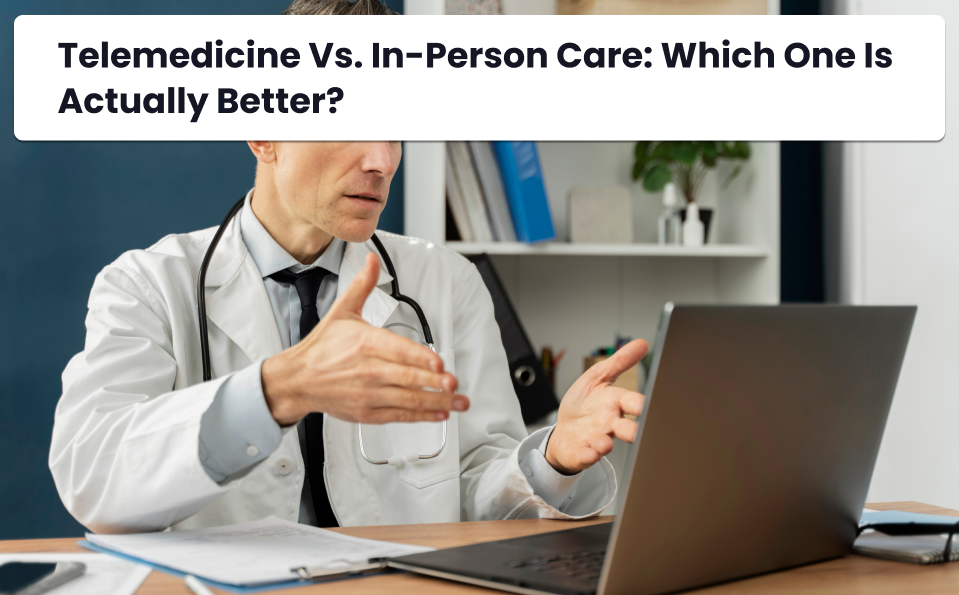
Telemedicine vs. In-Person Care: Which One is Actually Better?
Telemedicine, the practice of delivering healthcare services through digital platforms, has transformed the way patients access medical care in North America. This shift became particularly prominent during the COVID-19 pandemic, where telemedicine served as a vital alternative to in-person visits. However, each approach has its advantages and limitations. In this blog, we’ll explore the pros and cons of telemedicine and in-person care, helping you determine which option best suits your healthcare needs.
What Is Telemedicine?
Telemedicine allows healthcare providers to consult with patients remotely using video calls, phone calls, or specialized telehealth platforms. It is a convenient option for addressing non-emergency health concerns, managing chronic conditions, or seeking medical advice without leaving home.
Pros of Telemedicine
1. Convenient Accessibility
Telemedicine eliminates the need for travel, making it ideal for patients in rural or remote areas and those with mobility challenges. It enables access to quality healthcare that might otherwise require long trips to urban centers.
2. Cost Savings
Virtual consultations are often more affordable than in-person visits due to lower operational costs. Patients save on transportation and related expenses, and many insurance providers in the USA and Canada now cover telehealth services.
3. Faster Appointment Scheduling
Telemedicine often provides quicker access to healthcare professionals, which is especially beneficial for urgent, non-emergency issues. Waiting times for virtual consultations are usually shorter compared to scheduling in-person visits.
4. Continuity of Care
Telemedicine simplifies regular follow-ups and management of chronic conditions. Patients can maintain consistent care plans without frequent travel, ensuring their health needs are met with minimal disruption.

Cons of Telemedicine
1. Limited Physical Examination
One of the biggest drawbacks of telemedicine is the inability to conduct a thorough physical examination. Certain conditions may require in-person evaluation, which virtual consultations cannot adequately provide.
2. Technical Challenges
Telemedicine depends on reliable technology. Poor internet connectivity or lack of familiarity with telehealth platforms can disrupt appointments, causing delays and frustration.
3. Privacy Concerns
While most telehealth platforms prioritize security, sharing sensitive health information online can raise concerns about data breaches or unauthorized access.
In-Person Care: Pros and Cons
In-person care remains the traditional method of delivering healthcare services, involving direct interaction between patients and healthcare providers.
Pros of In-Person Care
1. Comprehensive Physical Examination
In-person visits enable hands-on evaluations, immediate diagnostic testing, and detailed physical assessments, ensuring accurate diagnosis and treatment.
2. Immediate Access to Diagnostics
Patients can undergo lab tests, imaging, and other necessary evaluations on the same day as their visit, minimizing delays in treatment plans.
3. Personalized Interaction
Face-to-face consultations allow for better communication and understanding, fostering a stronger patient-provider relationship.
Cons of In-Person Care
1. Time and Travel Requirements
Visiting a healthcare facility requires time and effort, especially for those living in rural areas or dealing with busy schedules. Long wait times and travel can add to the inconvenience.
2. Higher Costs
In-person visits can be more expensive due to facility fees and additional charges. Patients also incur travel costs, which can add to the overall expense.
3. Risk of Exposure
Attending a clinic or hospital increases the risk of exposure to infectious diseases, particularly during flu seasons or pandemics.
Choosing the Right Option
The decision between telemedicine and in-person care depends on your specific healthcare needs.
- Telemedicine is best for routine check-ups, minor illnesses, mental health consultations, and chronic condition management.
- In-person care is essential for emergencies, complex diagnoses, imaging, or surgical procedures.
Integrating Telemedicine and In-Person Care
Modern healthcare systems in the USA and Canada increasingly integrate telemedicine with in-person care to offer a hybrid approach. This ensures that patients can access the right type of care for their condition, leveraging the strengths of both methods.
For instance, a telemedicine consultation might be the first step in diagnosing a condition, followed by an in-person visit for further evaluation or treatment. Such flexibility enhances patient satisfaction and healthcare outcomes.
Final Thoughts
Telemedicine and in-person care each have their unique advantages and limitations. While telemedicine offers convenience, cost savings, and accessibility, in-person care remains indispensable for thorough examinations and complex treatments.
By understanding the pros and cons of both options, North American patients can make informed decisions about their healthcare, ensuring they receive timely and appropriate medical attention.





